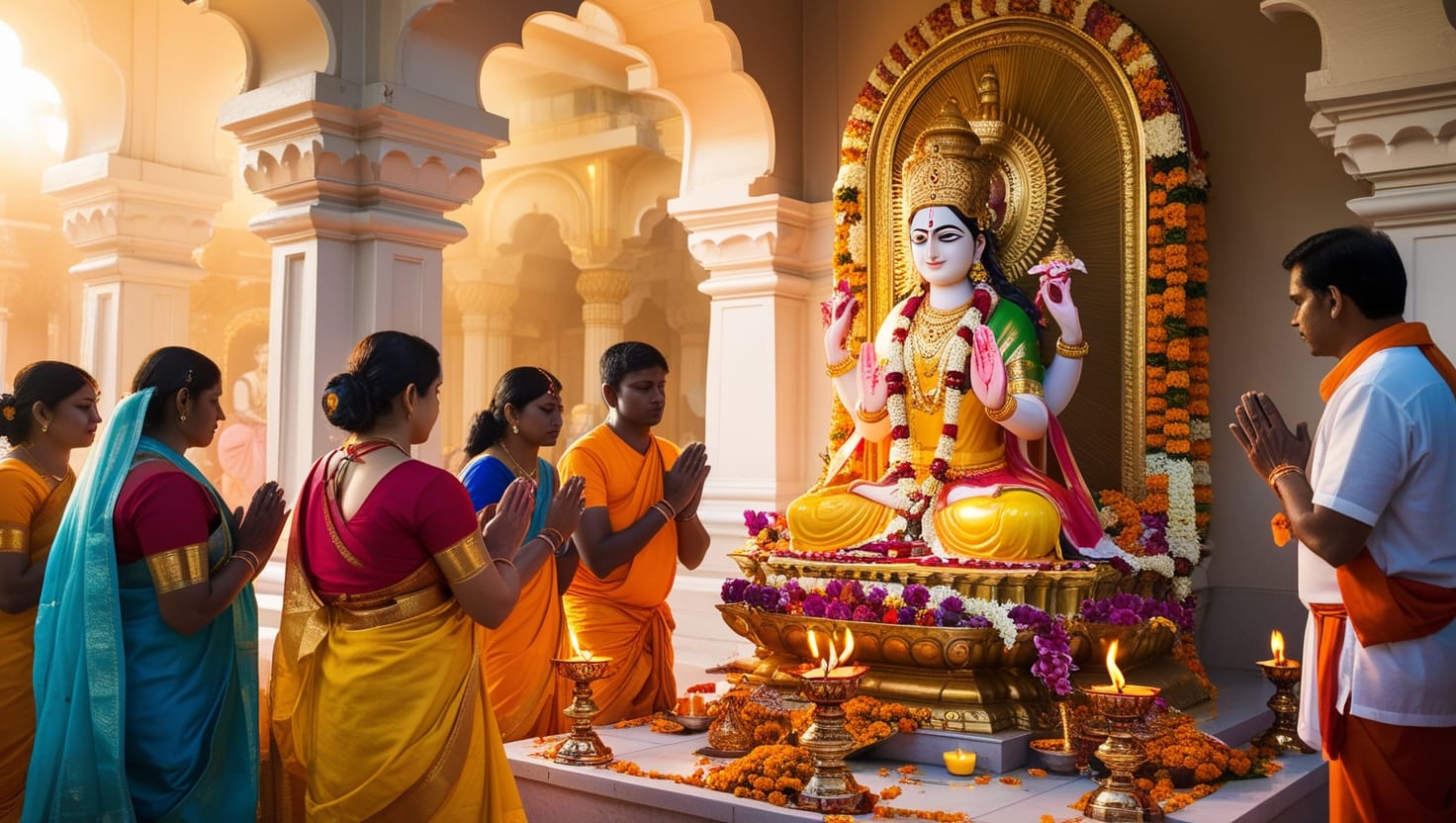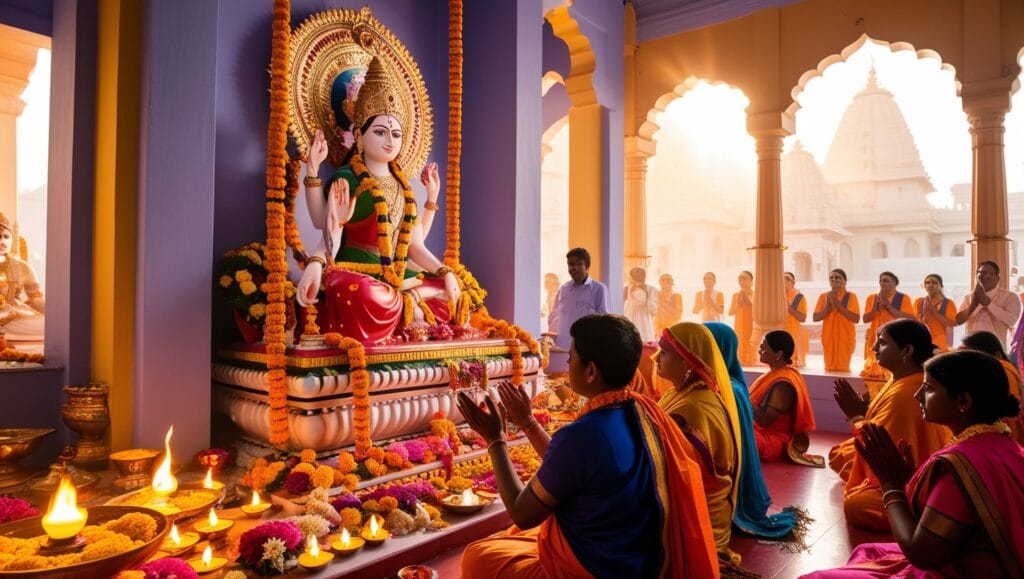introduction Navratri Day 4: Kushmanda
Navratri Day 4: Kushmanda marks a significant point in this vibrant festival dedicated to the divine feminine. Each day of Navratri celebrates a different goddess, and Day 4 honors Goddess Kushmanda, known for her nurturing and vibrant energy. In this blog, we will explore the traditions, colors, and significance of this auspicious day.
Table of Contents
The Significance of Navratri Day 4: Kushmanda
On Navratri Day 4, we celebrate Goddess Kushmanda, often depicted as having a radiant smile and glowing skin. She is the creator of the universe and symbolizes prosperity and good health. The name “Kushmanda” derives from “Ku” meaning “little,” “Us” meaning “light,” and “Amanda” meaning “brittle.” She represents the cosmic egg, or “Brahmanda,” from which the universe emerged.
The fourth day of Navratri also introduces the color orange, symbolizing warmth, joy, and enthusiasm. Wearing orange on this day enhances positivity and uplifts one’s spirit, aligning with the goddess’s qualities.

What to Wear on Navratri Day 4
Choosing the right attire is essential for honoring Goddess Kushmanda. Wearing the color orange on Navratri Day 4 is more than just a fashion statement. It invites energy and positivity into your life. Orange is associated with joy and creativity, making it a powerful choice for this day.
Benefits of Wearing Orange
- Boosts Creativity: Orange is linked to creativity. Wearing it can inspire innovative thoughts and artistic expression.
- Enhances Mood: The vibrant hue can uplift your mood and bring about feelings of happiness.
- Promotes Social Interaction: Orange is a friendly color that encourages socializing, perfect for communal celebrations during Navratri.
Navratri Day 4 Bhog and Prasad
On Navratri Day 4, special offerings are made to Goddess Kushmanda. The bhog, or food offerings, reflect the day’s spirit and include dishes that are light yet nourishing. Common offerings include:
- Kheer: A sweet rice pudding, often flavored with cardamom and garnished with nuts.
- Fruits: Fresh seasonal fruits symbolize the harvest and abundance.
- Sabudana Khichdi: Made from tapioca pearls, this dish is both filling and satisfying, especially for those observing fasts.
The prasad distributed after the rituals is blessed food, embodying the goddess’s energy and love. Consuming prasad is believed to bring good fortune and blessings.
Navratri Day 4 Aarti
Aarti is a significant ritual that involves singing hymns in praise of the goddess. The Aarti for Navratri Day 4 focuses on Goddess Kushmanda, invoking her blessings. Here’s a brief overview of the Aarti:
- Chanting: Devotees gather to sing the Aarti, creating a vibrant atmosphere filled with devotion.
- Significance: This ritual connects worshippers with the divine, fostering a sense of community and shared spirituality.
The Aarti Mantra
During the Aarti, the following mantra is often recited:
“Om Jai Jagdish Hare, Swami Jai Jagdish Hare…”
This powerful mantra resonates with the qualities of the goddess, inviting her presence into the worship space.
Navratri Day 4 Katha
The Katha, or story, associated with Goddess Kushmanda is a narrative that recounts her divine qualities and significance. It highlights her role in creating the universe and her nurturing nature. Here’s a summary:
Goddess Kushmanda is believed to have created the cosmos with her divine smile. She is also known to bestow health and wealth upon her devotees. By listening to her Katha, devotees draw inspiration from her strength and compassion, reminding themselves of the importance of nurturing one’s dreams and aspirations.
Navratri Day 4 Mantra
Reciting the mantra dedicated to Goddess Kushmanda on this day is believed to invoke her blessings. The mantra is as follows:
“Om Devi Kushmandayai Namah”
बीज मंत्र: कुष्मांडा: ऐं ह्री देव्यै नम:
पूजा मंत्र: ऊं कुष्माण्डायै नम:
ध्यान मंत्र: वन्दे वांछित कामर्थे चन्द्रार्घकृत शेखराम्। सिंहरूढ़ा अष्टभुजा कूष्माण्डा यशस्वनीम्॥
This powerful invocation aligns the devotee’s energy with that of the goddess, promoting health, prosperity, and spiritual growth
What We Should Eat on Navratri Day 4
Dietary choices during Navratri play a crucial role in spiritual practices. On Day 4, the focus is on satvik (pure) food, which nourishes both the body and the soul. Recommended foods include:
- Fruits: A variety of fresh fruits offer natural sweetness and energy.
- Kheer: This sweet dish nourishes the body and is a traditional offering to the goddess.
- Sabudana Dishes: Made from tapioca, these are filling and perfect for fasting.

What We Should Avoid on Navratri Day 4
To maintain the purity of the celebration, certain foods and activities should be avoided. These include:
- Non-Vegetarian Foods: To honor the goddess, it’s essential to abstain from meat and fish.
- Alcohol: Consuming alcohol is discouraged during this sacred time.
- Spicy and Processed Foods: These are believed to disrupt the balance of body and mind during fasting.
Spiritual Practices on Navratri Day 4
Devotees engage in various spiritual practices to honor Goddess Kushmanda. Here are some activities to consider:
- Meditation: Spend time in quiet reflection, focusing on the qualities of the goddess.
- Chanting: Recite the mantra dedicated to Kushmanda, inviting her energy into your life.
Participate in Aarti: Join community prayers, reinforcing the sense of togetherness during this festive period
Navratri Day 1 to 9 Goddess Names
The Navratri Day 1 to 9 goddess names are as follows:
- Shailaputri (Day 1)
- Brahmacharini (Day 2)
- Chandraghanta (Day 3)
- Kushmanda (Day 4)
- Skandamata (Day 5)
- Katyayani (Day 6)
- Kalaratri (Day 7)
- Mahagauri (Day 8)
- Siddhidatri (Day 9)
Conclusion: Embracing the Energy of Navratri Day 4
Navratri Day 4: Kushmanda is a time to embrace the divine feminine energy and reflect on the importance of nurturing creativity and joy in our lives. By wearing orange, offering bhog, and participating in Aarti, we honor the goddess and invite her blessings into our lives.
As you celebrate this vibrant day, remember the teachings of Goddess Kushmanda. Let her story inspire you to cultivate health, wealth, and happiness. Through devotion and spiritual practices, may you experience the profound energy of Navratri Day 4.
FAQ: Navratri Day 4: Kushmanda
What does Navratri Day 4 signify?
Navratri Day 4 celebrates Goddess Kushmanda, who is known as the creator of the universe. This day focuses on her nurturing qualities and symbolizes prosperity, health, and joy.
Why is orange the color for Navratri Day 4?
Orange represents warmth, enthusiasm, and creativity. Wearing this color on Day 4 is believed to enhance positivity and align with the vibrant energy of Goddess Kushmanda.
What are some traditional foods offered on Navratri Day 4?
Common offerings include kheer (sweet rice pudding), fresh seasonal fruits, and sabudana khichdi (tapioca dish). These foods are light, nourishing, and align with the satvik diet encouraged during Navratri
What is the significance of the Aarti on this day?
The Aarti is a ritual that involves singing hymns in praise of Goddess Kushmanda. It creates a communal atmosphere of devotion and connects worshippers with the divine.
What is the mantra for Navratri Day 4?
The mantra for this day is *“Om Devi Kushmandayai Namah.”* Chanting this mantra is believed to invoke the goddess’s blessings of health and prosperity.
What activities should be avoided on Navratri Day 4?
Devotees should refrain from consuming non-vegetarian foods, alcohol, and spicy or processed items to maintain the purity of the celebration.
How can one celebrate Navratri Day 4 at home?
You can celebrate by wearing orange, preparing traditional bhog, participating in Aarti, and reciting the mantra dedicated to Goddess Kushmanda. Meditation and reflection are also encouraged.
What is the Katha associated with Goddess Kushmanda?
The Katha recounts the story of Goddess Kushmanda’s creation of the universe through her divine smile and her role in bestowing health and wealth upon her devotees.
How can wearing orange benefit me on Navratri Day 4?
Wearing orange can boost creativity, enhance your mood, and promote social interaction, all of which align with the joyful spirit of the day.
Why is it important to engage in spiritual practices during Navratri?
Engaging in spiritual practices fosters a deeper connection with the divine, enhances personal growth, and cultivates a sense of community and devotion during this auspicious festival.















6 thoughts on “Navratri Day 4: Kushmanda – Embracing Divine Energy”
Comments are closed.